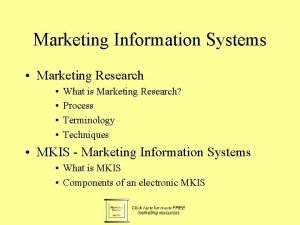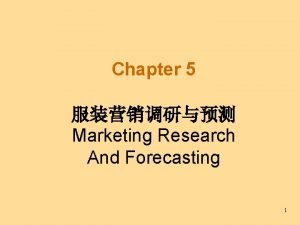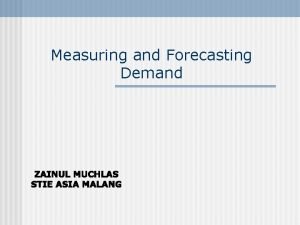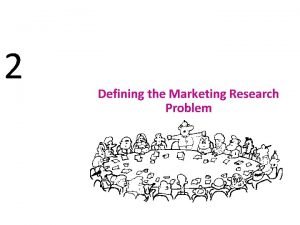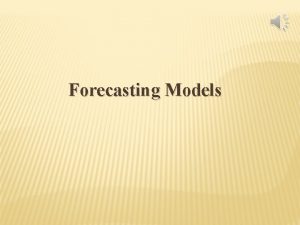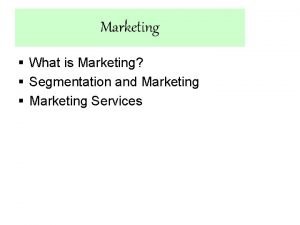Chapter 5 Marketing Research And Forecasting 1 5























- Slides: 23

Chapter 5 服装营销调研与预测 Marketing Research And Forecasting 1

5. 1 市场营销信息系统的构成 The Components of Marketing Information System 5. 1. 1 营销信息系统的概念 The Concept of M IS 营销信息系统由人、设备和程序组成,它为营销决策 者收集、挑选、分析、评估和分配需要的、及时的和 准确的信息。 A marketing information system(M IS) consists of people, equipment, and procedures to gather, sort, analyze, evaluate, and distribute needed, timely, and accurate information to marketing decision makers. 2

The Marketing Information System Marketing Decisions and Communications Marketing Managers Marketing Information System Distributing Information Assessing Information Needs Developing Information Analysis Internal Databases Marketing Research Marketing Intelligence Marketing Environment 3

5. 1. 2 营销信息系统的构成 The Components of Marketing Information System 内部报告系统 Internal Records System 营销决策 支持系统 Marketing Decision Support System 营销情报系统 Marketing Intelligence System 营销调研系统 Marketing Research System 4

5. 1. 2 The Components of Marketing Information System 1. 内部报告系统 Internal Records System • 订单—收款循环 The Order-to-Payment Cycle (Wal-mart) • 销售信息系统 Sales Information System 5

5. 1. 2 The Components of Marketing Information System 2. 营销情报系统 Marketing Intelligence System 营销情报系统是使公司经理获得日常的关于营销 环境发展的恰当信息的一整套程序和来源。 A marketing intelligence system is a set of procedures and sources used by managers to obtain everyday information about developments in the marketing environment. 6

5. 1. 2 The Components of Marketing Information System 3. 营销调研系统 Marketing Research System 营销调研是系统的设计、收集、分析和提出数据资 料以及提出公司所面临的特定营销状况有关的调查 研究结果。 Marketing research is the systematic design, collection, analysis, and reporting of data and findings relevant to a specific marketing situation facing the company. (营销调研步骤见7. 2) 7

5. 1. 2 The Components of Marketing Information System 4. 营销决策支持系统 Marketing Decision Support System 营销决策支持系统是一个组织,它通过软件与硬 件支持,协调数据收集、系统、 具和技术,解 释企业内部和外部环境的有关信息,并把它转化 为营销活动的基础。 A marketing decision support system (MDSS) is a coordinated collection of data, systems, tools, and techniques with supporting software and hardware by which an organization gathers and interprets relevant information from business and environment and turns it into a basis for marketing action. 8

5. 2 营销调研的步骤 The Marketing Research Process 确定问题和调研目标 Defining the problem and research objectives 制定调研计划 Developing the research plan for collecting information 执行调研计划——收集和分析信息 Implementing the research plan -collecting and analyzing the data 陈述研究发现 Interpreting and reporting the findings 9

Step 1. 确定问题和调研目标 Defining the Problem & Research Objectives 探测性调研 • Gathers preliminary information that will help define the problem and suggest hypotheses. 描述性调研 • Describes things as market potential for a product or the demographics and consumers’ attitudes. Exploratory Research Descriptive Research 因果性调研 Causal Research • Test hypotheses about causeand-effect relationships. 10

Step 2. 制定调研计划 Develop the Research Plan • Research plan development follows these steps: –资料来源 – 调研方法 – 调研 具 – 抽样计划 Data sources Research approaches Research instrument Sampling plan 11

(1) Develop the Research Plan. Data Sources 资料来源 Gathering Secondary Information 二手资料 Both Must Be: 一手资料 Information That Already Exists Somewhere. + Obtained More Quickly, Lower Cost. -- Might Not be Usable Data. 相关的 Relevant 准确的 Accurate 及时的 Current 客观的 Impartial Information Collected for the Specific Purpose at Hand. 12

(2)Develop the Research Plan. Research Approaches 调研方法 Planning Primary Data Collection 观察法 Observational Research Gathering data by observing people, actions and situations (Exploratory) 访问法 Survey Research Asking individuals about attitudes, preferences or buying behaviors (Descriptive) 实验法 Experimental Research Using groups of people to determine cause-andeffect relationships (Causal) 13

Planning Primary Data Collection Contact Methods 14

(3)Develop the Research Plan. Research Instruments 调研 具 问卷 Questionnaires 15

(4)Develop the Research Plan. Sampling Plans 抽样计划 Planning Primary Data Collection 抽样单位 抽样方法 Probability or Non-probability sampling? 抽样程序 How should the sample be chosen? Sample representative segment of the population Who is to be surveyed? (What Sampling Unit? ) 样本量 How many should be surveyed? 16

Step 3. 执行调研计划 Implementing the Research Plan 收集信 息 Collecti ng the 加 信 Data 息 Proces sing the 分析信 Data Research Plan 息 Analyzi ng the Data 17

Step 4. 陈述研究发现 Interpreting and Reporting Findings 调研者应提出对管理决策有用的重要发现。 Researcher Should Present Important Findings that are Useful in the Major Decisions Faced by Management. Step 1. 解释发现 Interpret the Findings Step 2. 得出结果 Draw Conclusions Step 3. 向管理层报告 Report to Management 18

5. 3 市场需求的测量与预测 Demand Measurement and Forecasting • 市场需求的测量 The measures of Market Demand • 测量哪个市场? Which Market to Measure? • 需求测量的有关词汇 A Vocabulary for Demand Measurement • 估计目前市场需求 Estimating Current Demand • 估计未来需求 Estimating Future Demand 19

市场需求的测量 The measures of Market Demand Total Potential 100% 10% 总市场 Total Market Potential 100% Available 40% Qualified Available 20% Target Penetrated 10% 5% 0 潜在市场 Potential Market 20

A Vocabulary for Demand Measurement • • • 市场需求 Market Demand 市场预测 Market Forecast 市场潜量 Market Potential 企业需求 Company Demand 企业销售预测 Company Sales Forecast 企业销售潜量 Company Sales Potential 21

估计目前市场需求 Estimating Current Demand • 总市场潜量 Total Market Potential • 地区市场潜量 Area Market Potential • 行业销售额和市场份额 Industry Sales and Market Shares 22

估计未来需求 Estimating Future Demand • 购买者意图调查法 Survey of Buyers’ Intentions • 销售人员意见综合法 Composite of Force Opinions • 专家意见法 Expert Opinion • 过去销售额分析 Past-Sales Analysis • 市场测试法 Market-Test Method 23
 Conducting marketing research and forecasting demand
Conducting marketing research and forecasting demand Conducting marketing research and forecasting demand
Conducting marketing research and forecasting demand Marketing research and forecasting demand
Marketing research and forecasting demand Finer segmentation strategies
Finer segmentation strategies Marketing information systems and marketing research
Marketing information systems and marketing research Define marketing information management
Define marketing information management Marketing information systems and marketing research
Marketing information systems and marketing research Marketing information systems and marketing research
Marketing information systems and marketing research Marketing information systems and marketing research
Marketing information systems and marketing research Forecasting and demand measurement
Forecasting and demand measurement Ninety types of demand measurement
Ninety types of demand measurement Forecasting and demand measurement in marketing
Forecasting and demand measurement in marketing Measuring and forecasting demand
Measuring and forecasting demand Ninety types of demand measurement
Ninety types of demand measurement Gathering information and measuring market demand
Gathering information and measuring market demand Long term and short term financial planning
Long term and short term financial planning Marketing research problem example
Marketing research problem example Chapter 29 conducting marketing research answers
Chapter 29 conducting marketing research answers What is forced choice questions
What is forced choice questions Chapter 28 marketing research
Chapter 28 marketing research Chapter 28 marketing research
Chapter 28 marketing research Marketing research chapter 1
Marketing research chapter 1 Chapter 29 conducting marketing research
Chapter 29 conducting marketing research Marketing research suppliers and services
Marketing research suppliers and services




